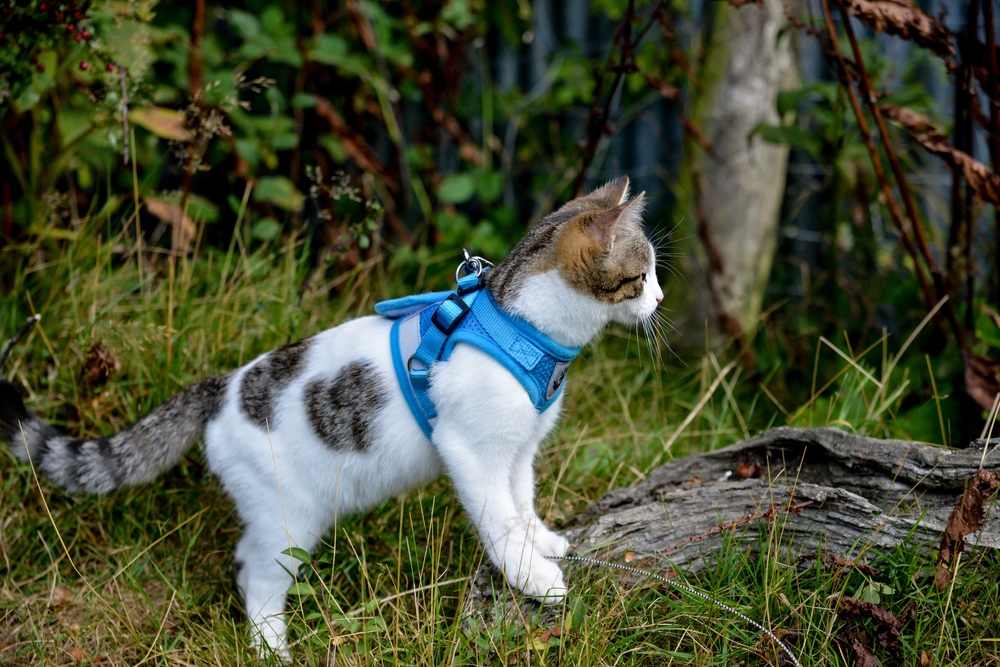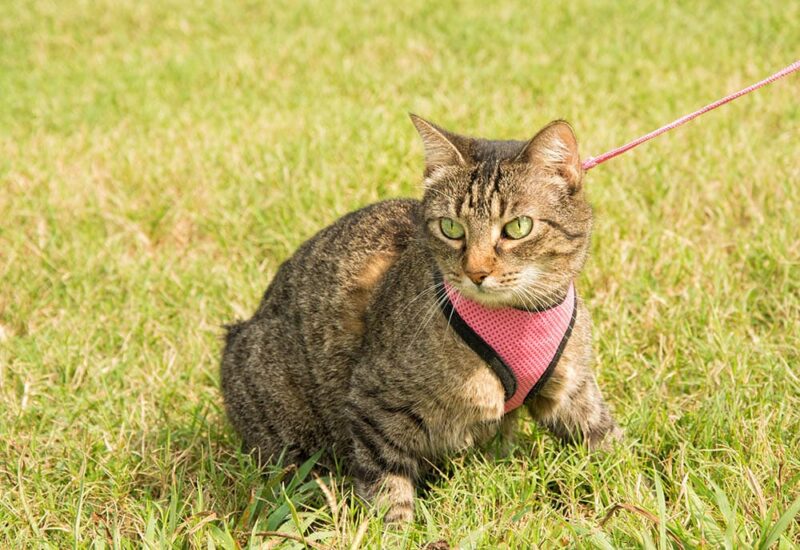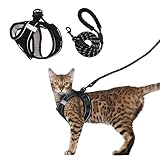Training your cat to walk with a harness and leash is an excellent option if you want your kitty to enjoy outdoor adventures. However, the first time many cats wear a harness, they simply fall over on their side. But why does this happen?
Generally, cats fall over because the harness feels like being grabbed by a predator. Falling over and freezing is an instinctive survival response. If you want your cat to learn to walk on a leash, you must help them overcome this instant reaction.
In this article, you’ll learn why wearing a harness can cause your cat to fall over. Plus, we’ll give you tips on teaching your cat to wear a harness and how to prepare them for spending time outside.

Getting to the Root of the Harness Response
Take a look at where your cat’s harness places pressure on their body. Most of the time, much of the pressure falls between the shoulder blades and around the chest. For adult cats, being grabbed or held in this area can be a traumatic experience.
Mother cats regularly carry their babies by the scruff of their necks. At that age, being scruffed triggers the kitten to relax. However, adult cats lose this instinct as they grow.
Adult cats are typically only grabbed by the scruff during mating or by a predator, which can be a stressful experience. With this knowledge, it makes sense why a cat might react to a harness by freezing and falling over.

Teaching Your Cat to Wear a Harness
So, how do you help your cat overcome their natural fear and learn to wear a harness? The answer is usually A) slowly and B) with a lot of treats!
- First, make sure you buy the right size harness for your cat. It’s best to follow the sizing and measuring directions for the harness you’re considering. Try to purchase an adjustable harness to make the fit as close and comfortable as possible.
- Introduce the harness indoors where your cat is safe and comfortable. Start by allowing them to sniff and interact with the harness. Try using catnip or a cat pheromone spray on the harness to hold your kitty’s attention and keep them calm.
- Once your cat is familiar with the sight of the harness, start getting them used to it touching their body. Hold the harness against them and reward your cat with treats or praise if they stay calm. Slowly practice placing the harness over their head or beneath their body.
- Work your way up to placing the entire harness on the cat, rewarding them generously for staying calm. Your cat should be able to wear the harness indoors with no fuss before you move on to leash training. Adjust the harness as needed to ensure it fits snugly and won’t slip off.
- Every cat will progress through the stages of harness training at their own pace. If your cat shows signs of fear or discomfort, including falling over, repeat the previous step in the training process.
Are you looking for the perfect cat harness? We suggest Hepper’s Cat Harness & Leash Set, which includes a nicely designed, machine-washable harness made from soft, sturdy velvet and mesh.
Hepper Cat Harness and Leash Escape Proof Set -…
- Escape Proof – Cat leashes and harnesses for walking aren’t all equally secure. Our double aluminium…
- Superior Comfort – Our cat harnesses are lightweight, made with premium velvet fabric, breathable…
- Free Extra Strength Leash – You don’t need to worry about your cat escaping this harness. This cat…
This harness is easy to put on and take off and features reinforced stitching, reflective stripes, and quick-release buckles. This set also includes a great leash made from durable nylon climbing rope.
At Catster, we’ve admired Hepper for many years and decided to take a controlling ownership interest so that we could benefit from the outstanding designs of this cool cat company!
Preparing Your Cat to Spend Time Outside
Training your cat to wear a harness is only one step in the process of preparing your cat to spend time outside. The first thing you should do is make sure your pet is current on their vaccinations and appropriate parasite prevention. Talk to your vet about whether your cat is healthy enough to handle outdoor exercise, especially if they’re older or overweight.
💛 😺 Speak To a Vet Online From the Comfort of Your Couch!

If you need to speak with a vet but can’t get to one, head over to PangoVet. It’s an online service where you can talk to a vet online and get the personalized advice you need for your pet — all at an affordable price!
For indoor cats, the world outside can be overwhelming at first. The sights, sounds, and smells outside are far more stimulating than those found in the safety of a house. Even the most well-adjusted cat may be frightened the first few times they venture outside.
To help ease your cat into the outdoors, try letting them spend time on a screened porch or in a “catio.” These enclosed areas help your cat feel secure while introducing them to the stimulation of the outside world. Portable cat yards or tents are another option if more permanent structures aren’t available.
By the time you take your cat outside wearing a harness and leash, they should be comfortable and confident with the stimulation they’ll encounter there.

Conclusion
Despite what you might think, cats don’t fall over in a harness simply to provide you with viral social media content. Instead, they react this way because the harness triggers a survival response like they were grabbed by a predator. With patience and training, your cat can learn to overcome this reaction. Remember, not every cat will enjoy walking on a harness and leash. Consider your cat’s personality carefully before attempting to turn them into an adventurous kitty.
Featured Image Credit: Sari ONeal, Shutterstock

